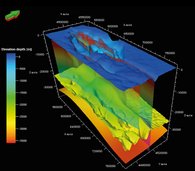3D Marmara
In this project, we develop a 3D lithospheric-scale structural model and a 3D conductive thermal model for the Sea of Marmara, including its adjacent onshore areas.
The Sea of Marmara and its basins mainly evolved due to the activities of the Thrace-Eskisehir Fault Zone (TEFZ) in the Neogene and the North Anatolian Fault Zone (NAFZ) in the Quaternary. At present-day, the Sea of Marmara is still evolving due to the NAFZ and the Marmara region is an earthquake hazard zone while hosting around 20 million of inhabitants.
For a better understanding of the tectonic processes and geodynamic evolution, it is important to assess the geological structure and the thermomechanical state of this region, considering variations in rheology and strength of the lithosphere in the Marmara region.
Therefore, we integrate different geological and geophysical data such as existing structural models, well data, and seismic observations to build a new 3D lithospheric-scale structural model which is additionally constrained by 3D gravity modeling.
The final 3D structural model differentiates various sedimentary, crustal and mantle units and is the base for calculations of the conductive thermal field and variations in integrated strength.
Partners:
Prof. Marco Bohnhoff, Section 4.2
Prof. Manfred Strecker, University of Potsdam
Dr. Oliver Heidbach, Section 2.6
Dr. Murat Nurlu, Head of Earthquake Department Disaster and Emergency Management Authority – AFAD, Ankara, Turkey
Dr. Ershad Gholamrezaie, Umea University, Umea, Sweden




